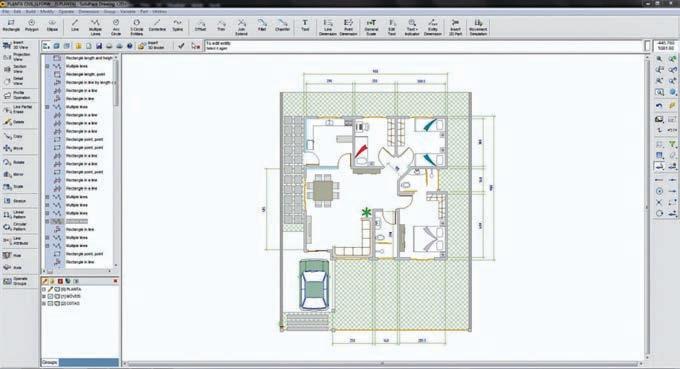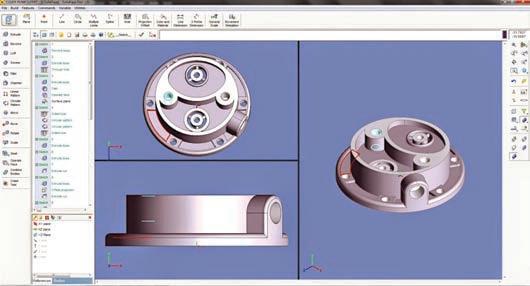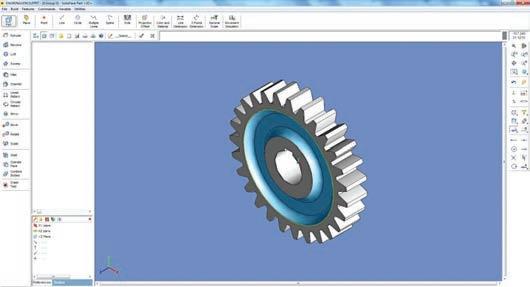
7 minute read
Software firm’s struggles an object lesson in challenging CAD business
The Mystery of SolidFace
Software firm’s struggles an object lesson in the challenges of making it in the 3D CAD business. BY RALPH GRABOWSKI
We’re all too familiar with big-spending CAD vendors like Autodesk, Dassault Systemes and Siemens and their millions of users. We might even have some familiarity with smaller CAD vendors, who are content to serve tens of thousands of customers.
But there’s a class of CAD vendor that never made it big – or at all. For instance, 2012 to 2014 was a shining era that saw the birth of a brand-new style of design software: Collaborative cloud-based CAD. Companies had names like sunglass.io, TinkerCAD, To3D and Onshape. All of them were taking advantage of the power granted by then-new WebGL and JavaScript APIs that made interactive 3D CAD graphics possible in Web browsers. None did well on their own.
One company you may not have heard of is SolidFace. I was alerted to this MCAD vendor when a reader told me about the company’s odd condition for using their free 30-day demo: Before downloading, you need to provide a credit card number.
Searching around, I discovered that a number of people had been caught o guard by the company’s arguably sly sales strategy. In a number of online forums, including Reddit, SourceForge, TrustPilot, and the U.S. Better Business Bureau, users complained that their credit cards had been charged for the free demo, sometimes multiple times, for amounts ranging from $65 to $89. Said one complainant, “I requested a refund and they said it would take 1-3 months for it to be processed due to the COVID situation.”
What isn’t immediately apparent is that downloading the software represents acceptance by the user of the software’s terms and conditions, a link to which is alluded to during the download process. Within those
Solid Face is based on UniCAD and offers many of the 2D drafting functions expected in CAD.
terms is a paragraph revealing that using the software past the 30-day demo period incurs a monthly charge. Typically, demo software like this simply de-activates after 30 days or significantly cripples the available functions.
Curious, I dug a bit deeper. The history of SolidFace begins in 1994 with the launch of a Brazilian 2D CAD program named UniCAD. Over its life, it gained 4,000 customers, primarily in Latin America. According to tech startup community site, F6S, Solid Face founder Oscar Leite spent more than 20 years at UniCAD before exiting the company in 2008 with $2.8 million. He described himself as a back-end programmer and UI/UX designer, getting his university training in Germany
In 2013, Leite formed SolidFace with Rafael Lima, according to Leite’s LinkedIn profile. Lima, then 28, had spent his first years post-university dabbling in Bitcoin mining. “During the dark days of BTC as a younger, savvy tech teenager, I was looking for something di erent to do with my computers and found BTC in the corners of the web or dark-web,” Leite wrote on LinkedIn.
Leite and Lima’s idea was to release a collaborative 3D parametric CAD program. The co-founders combined Lima’s knowledge of crypto-currency mining with Leite’s CAD experience. The free-of-charge program would make money for its owners by Bitcoin-mining using designers’ computers in the background, with the permission of users. According to Austin Business Journal, the company could make 4 cents per minute per user with this technique.
At the time, Leite described the new software as “Google Docs for 3D models,” even though SolidFace would run on the desktop, save files to the desktop (for intellectual property protection), and use the cloud only to store files and collaborate. Today, this is quite common among CAD programs.
According to its Tumblr account, the company spent $2.5 million to develop SolidFace and released the first beta test version in the middle of 2012. By 2014, the company was working to attract dealers and looking to advertise in publications.
Potential dealers were told,
“SolidFace’s growth is in the mid-range CAD market. SolidFace is fully compatible with Solidworks, Solid-Edge, AutoCad and others through SIEMENS-Parasolid core. The core also allows us to use full 3D modeling power.”
The compatibility referenced here was through Parasolid’s X_T/X_B formats and AutoCAD’s DWG/DXF formats. Although their marketing claimed 100% compatibility with Solidworks, NX, and so on, it’s not possible with a neutral file format.
One international dealer, that SolidFace approached, told me, “I tried SolidFace once. For me it wasn’t worth the extra learning curve compared to Rhino and BricsCAD, and also [there was] no money in it as far as I could see.”
There didn’t seem to be much money in it for SolidFace either. “Bootstrapping both of our CAD companies, UniCAD and SolidFace, has proven to be a significant challenge. During this period we’ve invested over $1.5 million in research and development...,” the company stated as part of a 2015 Kickstarter campaign for a service called Solid Share.
Solid Share was to be a 3D printing, scanning and modeling service that used SolidFace as the CAD engine. Users could design with the CAD program for free, and presumably Solid Share would charge a fee for the services users accessed. The campaign failed after it raised just US$1,823 toward its goal of US$385,000.
That same year, the company also took a stab at marketing SolidFace through Steam, the online computer game retail portal. For the first and only time, pricing was on a non-rental basis; the student version went for US$199, while commercial versions ranged from US$500 to $1,000. This sales channel eventually fell through when the company decided their software would not be updated to version 2016 on Steam.
By 2017, SolidFace had sold just 600 licenses. Of these, 100 were paid for by Bitcoin mining, making the company $1,400 a month, according to the Austin

Solid Face’s 3D modeling runs on the Parasolid kernel and features a visual history tree.









Solid Face at one time offered basic 3D solid modeling at a low price but now is no longer available.
Business Journal. They offered a non-mining version at $29.99/month. That same year, the company looked to raise US$500,000 as a seed round. According to CrunchBase, it landed US$50,000 from four venture capital funds, lead by growth accelerator firm Turn8.
In either 2018 or 2019, Leite and Lima formed a third venture, Solid Network, for distributing software. “We partner with software companies to distribute their software for free in our marketplace using their user’s hardware (GPU) to monetize it while the device is online,” the company reported on its Solid Networks Linked-In company page. However, the solidnetwork.com domain, set up in early 2020, currently resolves to an empty “placeholder” site.
Today, the SolidFace Web site reports the following software pricing. Its 2D version, SolidFace PTV, runs $89 per quarter with a “30 days free and cancel anytime” o er. SolidFace 3D Pro costs US$129 per month but hasn’t been released yet; it is “coming soon.”
While the company’s software doesn’t seem to have been successful in the marketplace, the training it provides is quite good. There are lots of 2D and 3D tutorial videos on Youtube and the user manual (which I reviewed) is well written. However, I wasn’t able to access a version of the SolidFace software, and so I cannot attest to its abilities.
The story of SolidFace is a remarkable one, as two founders, flush with cash and full of ideas, launched a CAD program, and then pivoted repeatedly in their attempts to succeed.
But as the founders of sunglass.io, TinkerCAD, To3D, and Onshape discovered, MCAD program running on new WebGL technology is not necessarily a winner. |DE
https://solidface.com
Ralph Grabowski writes on the CAD industry on his WorldCAD Access blog (www.worldcadaccess.com) and weekly upFront.eZine newsletter. He has authored numerous articles and books on CAD, Visio and other design software applications.




